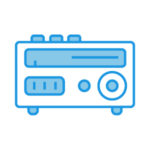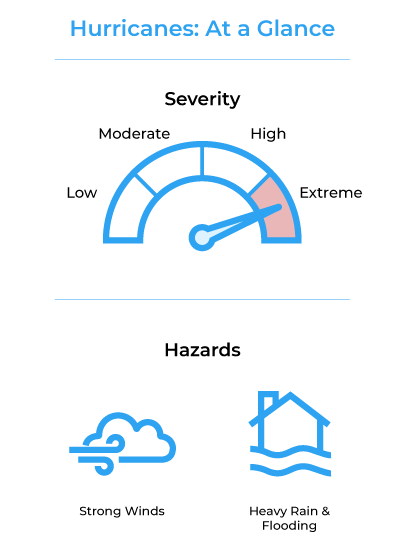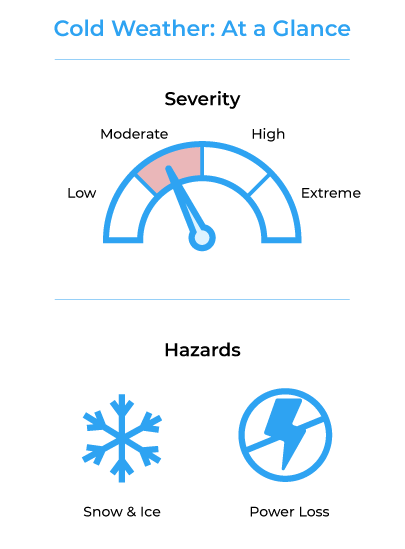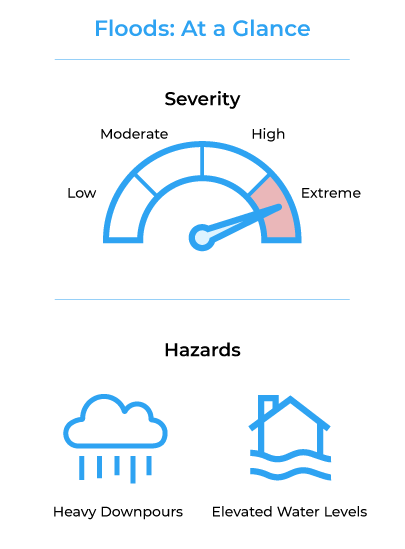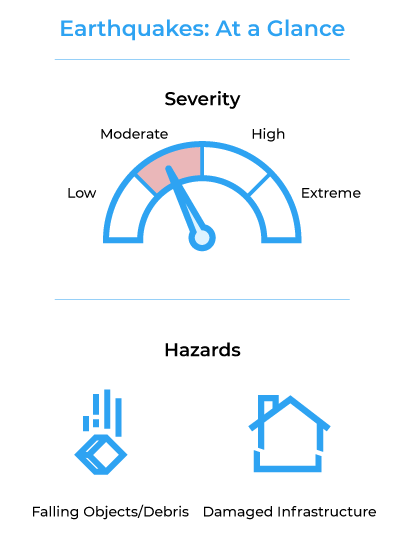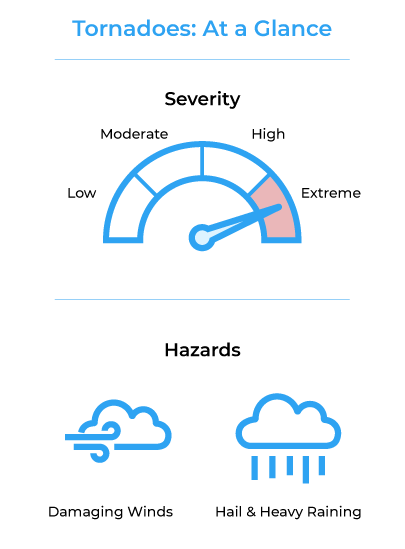Disaster Preparedness
A Complete Guide for Seniors
Updated on: December 2022

We Support
Table Of Contents
Natural disasters put everyone in their path at risk. Whether it’s a hurricane, a wildfire, a winter storm, or even a heat wave, lives can hang in the balance. But seniors are even more at risk, and the numbers only make this more clear. Here are some eye-opening statistics:
- Adults 75 and older made up half the deaths from Hurricane Katrina
- After a heat wave hit Chicago in 1995, adults 65 or older made up almost two-thirds of fatalities after a 1995 heat wave hit Chicago
- People over 85 are more than four times more likely to die in a wildfire than the total population
What’s even more worrying is that for a number of reasons, including scarce financial resources, isolation, and problems with mobility, it can be hard for seniors to prepare for disasters. For example, a study done in 2012 indicated that close to one in six adults over 50 would need help evacuating their homes in an emergency, and nearly one in 10 would need help from outside the household. Despite such risks, however, a 2014 study found that less than a quarter of seniors have made plans for responding to a natural disaster. And senior service professionals are frequently also unprepared to help the seniors in their communities respond.
It’s essential, then, for seniors and the people who care for them to give a lot of thought to how best to respond to natural disasters. They should, ideally, plan and prepare for them.
Helping Loved Ones Prepare
It’s natural for the family and friends of an older person to want to be involved in helping them prepare. After all, a natural disaster can be especially worrisome for the friends and families of seniors who might be at risk. And a senior’s support network can provide a lot of assistance before and during an emergency.
Note, too, that helping a senior weather an emergency can help the entire community where they live. Older people tend to have important practical knowledge, knowledge of local services, and robust social networks, and studies have shown that seniors often contribute to the resilience of their communities after a natural disaster. So that makes it all the more important to lend a hand to make sure seniors are ready to respond.
If you’re ready to help the senior in your life prepare for emergencies, here are some things you can do.
A study done in 2012 indicated that close to one in six adults over 50 would need help evacuating their homes in an emergency, and nearly one in 10 would need help from outside the household.
A study done in 2012 indicated that close to one in six adults over 50 would need help evacuating their homes in an emergency, and nearly one in 10 would need help from outside the household.
Resources
A senior’s support network can help them access vital community resources. This begins by assessing the services that might be available in a natural disaster. You can start by getting in touch with the local senior services agency (and if you don’t know what agency to contact, a call to the local United Way could help). Talking to these agencies, you can get information about the types of events they expect to deal with in the area and the services they offer. One essential service is help with transportation: if evacuation becomes recommended or mandatory, many communities provide transportation to seniors who can’t get away otherwise.
Planning
Along the lines of getting familiar with local services, you can also help the senior plan for an emergency. Are there likely to be shelters nearby? What are the best routes to get there? What should they keep on hand in case they get stuck in the house or have to leave on short notice? Has the home received the sort of routine maintenance that would enable it to weather a storm? There is so much that can be done long beforehand to prepare for a disaster that it’s incumbent on a senior’s support network to help make that planning and preparation happen.
Awareness
It can be easy for seniors to be unaware of local conditions: they may not be tuned in to local weather reports, or they may be unaware of the severity of a storm or heat wave coming their way. One thing that people can do to help is check in to make sure that seniors are aware of any potential threats and to encourage them to take appropriate action.
Contact
Once the senior is aware of an event, checking in as the situation develops can also be a big help to them. Not only does it mean that there’s someone else who can seek help if it’s needed, staying in touch provides important moral support for what is probably a very trying time.
Encouragement
Moral support can mean a lot, especially if a senior faces the difficult choice between staying in the home and evacuation. There’s no way of knowing the right choice ahead of time, but having someone offer reassurance and feedback (and, potentially, a place to stay) will help ensure that the senior makes the right decision.
Accountability
Finally, not all seniors live on their own. If your loved one is in senior housing, check with the people running that facility. Do they have a stock of supplies? Do they have transportation they can use in an emergency? Have they made arrangements for shelter in a safe location? Not all facilities make such plans: it often depends on how independent their residents are. But it’s important to find out, and it’s essential to be ready to fill in any gaps in preparedness.
Getting Ready: Advanced Planning
There are many different kinds of natural disasters, and each one presents its own challenges. Later in the article, we address several of these different events specifically, but there are some significant similarities in the ways people should prepare for any natural disaster, and seniors and their loved ones should go through this planning process regardless of the risks they’re likely to face.
As you begin the planning process, ask yourself: what are the particular risks that you could face where you live?
Assess Your Risk
As you begin the planning process, ask yourself: what are the particular risks that you could face where you live? For example, if you live in the southeast, how often has your area experienced a hurricane in the past few years? If you live on the Pacific coast, how likely is your area to experience an earthquake? Has your area ever had to worry about wildfires? Tornadoes? Winter storms? We’ll go into the details of how to prepare for specific natural events later, but as you plan, it’s best to be aware of the types of emergencies you might face.
Assess Your Needs
As you plan, you’ll also want to take an objective look at your own needs. What medicines do you take on a regular basis? Do you need regular in-office medical treatments? Are you fully mobile? Are you able to drive? Do you depend on volunteers or government agencies for meal delivery or other services? Planning for a disaster means getting a clear sense of the help you’ll need if your community experiences a significant disruption.
Find Resources
Being prepared means more than just looking at your needs and trying to take care of them on your own. Many communities have plans in place for helping seniors in the event of an emergency. By getting in touch with your local government, senior services agency, or disaster planning office, you may be able to access services that will make it much easier to ride out a natural event. And these agencies may also offer tools or classes that can make your own preparations easier as well.
Many communities have plans in place for helping seniors in the event of an emergency.
Make an Evacuation Plan
Not all emergencies will require you to leave your home, but many might. In that case, it’s good to know ahead of time where you will go and how you will get there. You can start by deciding where you want to shelter: if you have a support network you can ask them if they’ll take you in in the event of a disaster. If you don’t have a local network (or if your local network consists entirely of people who might have to hit the road along with you), contact your local disaster preparedness agency to find out where they’re likely to set up shelters. In an event like a hurricane or winter storm, you can also find out this information by monitoring emergency broadcasts as the threat approaches. Finally, it’s essential to know local evacuation routes in the event of a hurricane and the best and fastest ways to get to high ground if your area is at risk for flooding.
Set Up a Support Network
Whether you have friends and family the next town over or across the country, you’ll want to choose the people you’ll be in touch with ahead of time. Before anything happens, make a plan with them for how often you’ll be in touch. If you have evacuation plans, let them know what they are and advise them of where you’re likely to end up; if you plan to stay in place, let them know this as well. It can also help to have the numbers, e-mails, and other contact information of your network printed up: super-prepared people include a copy of this printout with their vital documents and leave a copy behind in their home if they’re forced to evacuate.
Get Your Home Ready
Not every potential disaster warrants the same response, but many kinds of events can put a stress on a home—and make it essential that your home stays comfortable and safe. So as you think about the issues you might face, consider the ways that you can make improvements to your house. Are you worried about winter storms? Take steps, like weatherstripping, that will make it easier to heat. Are you worried about floods? There are also certain things you can do that will make them less damaging. What’s more, local agencies and charities sometimes offer such services for free or at a discount to seniors in need, so looking into the possibility now could improve your life even if you never face a disaster.
Prepare for Recovery
If you can, long before a disaster hits, you may want to review what your insurance will cover if you experience property damage. If you think you’re at risk for a catastrophic disaster, it can also be wise to document your valuables (you can even do this with a video camera). And you can also take one invaluable step that will make it easier in the hours and days following a disaster: set up direct deposit of any benefits you receive, like Social Security, disability benefits, or a pension. That way you’ll be able to access your money no matter where you are.
Getting Ready: Assemble your Emergency Preparedness Kit
Once you’ve done your planning, you’ll want to assemble an emergency preparedness kit.
The idea behind the kit is to give someone enough supplies to be comfortable and safe until emergency services can arrive in the area and the community begins to recover.
Since that’s the main reason to have such a kit, what you put into it may vary depending on the risks you face. If you live in a place where you can expect severe winter weather, for example, but you also live in a city or town that routinely deals with such emergencies, you may need only to plan for three or four days of fending for yourself.
On the other hand, if you live in a rural area that repeatedly finds itself under threat from hurricanes, you may want to plan for a longer time before you can rely on community resources. And you may want to make sure that you can easily take the essentials on the road with you in case you’re ordered to evacuate.
The Basics
Still, there are some basic items that nearly every emergency response agency recommends including in your kit, and while the number of days you’ll need to plan for varies depending on the organization giving the advice, the generally recognized minimum is three to four days. Here are some of the basics:
-
Water
(A gallon per person per day
-
Food
Pre-prepared food: canned good, etc.
-
First-Aid Kit
With up-to-date equipment
-
A Flashlight
Battery-powered
-
A Radio
Battery-powered
-
Spare Batteries
For various electronics
Everything apart from the water would ideally be in a dedicated container that you can take out of the house quickly in case of evacuation.
The idea behind the kit is to give someone enough supplies to be comfortable and safe until emergency services can arrive in the area
Additonal Items
The basics will get you through if you’re deprived of food or water, but there are some additional items you may want to include in your kit as well. These include:
- Personal care items, like toothbrushes, soap, shampoo, and other toiletries
- Spare clothes
- Blankets or sleeping bags
- Rain gear
- Light sticks
Note that many of these items are likely to be necessary in the event of an evacuation order, so ideally, they’ll be ready to go and easily portable if you or someone helping you needs to put them in a car.
Documents
In addition to supplies, it’s important to prepare a packet of documents that are easily accessed in your home, or easy to bring along with you in case of an evacuation. These documents should include personal identification: you don’t need to keep your i.d. Or driver’s license in your emergency kit, but it may help to include photocopies of them. It can be helpful to have the following items as well:
It’s Important To Prepare Packet With Legal Documents In Case Of An Evacuation Order:
-
Legal Documents
-
Insurance Documents
-
Financial Documents
Legal Documents
Items like your will, any important contracts, the deed to your home, and titles to your cars and other vehicles can be helpful to have in the event of an emergency, particularly if the event you’re dealing with is likely to lead to property damage.
Insurance Documents
Along the same lines, it can be useful to have copies of auto insurance and homeowner’s insurance policies so you have them in a secure place even if you’re unable to return to your home.
Financial Records
Having a recent bank statement can be useful, as can information about your retirement accounts and credit cards. You may even want to include tax records.
Again, for the purposes of responding to an emergency, it’s probably enough that you simply make copies of these items and put them somewhere easily accessible. (Ideally, they’ll be in a waterproof envelope, folder, or binder—or even just a resealable plastic bag—inside your emergency response kit.)
Items Specially for Seniors
In addition to the standard recommendations for a preparedness kit, there are a number of items specific to seniors that you should probably include in your kit as well. These include:
Medications
You will probably want to include an additional weeks’ supply of medications in your kit. To get that extra supply, inform your doctor or other health care provider of the fact that you’re putting together an emergency supply.
Medical Equipment
You will also want to have supplies for your essential medical equipment. This can include:
- Batteries for hearing aids
- Spare pairs of glasses
- Spare dentures
- Equipment for monitoring blood sugar and blood pressure, if needed
- Spare oxygen tanks
Having spares of all of these items in your kit will save you time searching the house to make sure you haven’t forgotten anything.
Medical Documents
Just as with all the other essential documents you’ll want to have on hand, you’ll also want to have information about any medical needs you have. This should include:
Basic information like your blood type, any allergies you have, and a list of any conditions you’re dealing with.
- Information about your medical equipment needs
- A list of prescriptions you receive along with the dosages you take
- A list of contact information for your physicians
- Copies of your Medicare, Medicaid, and other types of insurance information.
Finally, if you have a service animal, it might be useful to include their documentation in your kit as well; for all pets, you may want to include immunization information among your documents in case you have to bring them to a shelter or board them somewhere.
Responding to Specific Emergencies
Different types of events require different responses, but there is some advice that applies in all situations. Whatever emergency you’re faced with you should:
Keep Informed
You can get specially made battery-powered radios that receive NOAA bulletins, but you can also get an ordinary battery-powered radio that will allow you to tune into local stations and get emergency bulletins that way. And if you have a cellular phone, you can look into subscribing to text alerts put out by your local government. However you do it, it’s essential to be able to access emergency information, especially evacuation orders and the locations of nearby shelters.
Stay in Touch
A network of supporters will only work if you use it. So be sure to stay in touch with your network. If you stay in your home, let them know. If you evacuate, let them know where you’re going. If you need help, don’t hesitate to call. Even if your network stretches across the country, people living elsewhere can often get help in your area that you may not be able to access.
Avoid Bad News
In an emergency, staying calm is essential. But even with the best of intentions, national news organizations tend to play up the danger that a storm or other event could pose, and also tend to focus on bad outcomes. Resist the temptation to watch this kind of coverage: you’ll want to stick to the facts and listen to the authorities.
Hurricanes
Hurricanes are, in a way, the reference point for all natural disasters. People know when they live in a hurricane-prone area, and they will usually have some warning that a hurricane is coming, even though the course of a storm can sometimes curve unpredictably. But that doesn’t change the fact that hurricanes are incredibly destructive, with high winds that can tear structures apart and rainfall and storm surges that can cause significant flooding.
Seniors can have particular difficulty making it through a hurricane. Evacuation especially may be difficult for those who can’t drive, or those who have mobility issues, and evacuation can sometimes be more difficult emotionally for seniors as well. And even though we have more sophisticated methods of predicting storms and their paths than ever before, it can also sometimes be difficult for seniors to access information about a storm’s approach.
If there’s a silver lining, it’s that, because hurricanes are the touchstone for disaster preparation, getting ready doesn’t require too much outside of the standard list of things to do. But seniors in hurricane-prone areas should be aware of some specific ways to prepare.
Special Plans
To prepare for hurricane season, the best strategy is to go all out—do the most you can to prepare for the worst. This includes:
- Take an inventory of valuables in case the storm damages the home. This can be as simple as taking a video or pictures of your home’s interior using the camera on your phone.
- Make your home as weather-proof as possible, including cleaning out gutters and downspouts and making sure sump pumps and other anti-flooding measures are in good condition. You may also want to make sure that valuable items and important documents are out of the range of any floodwaters.
- Be ready to evacuate. Try to make your emergency preparedness kit is as portable as possible, and, if you have a car, always leave it with at least half a tank of gas during hurricane season to facilitate a quick getaway.
Special Supplies
Again, hurricanes are the model for other weather events when it comes to preparation, so the general outlines of your emergency preparedness kit don’t need to change. If, however, you live in a rural area that’s hurricane-prone, or if you live right on the coast, you may want to add a few more days’ worth of extra batteries, medications, and water and food supplies. In a severe hurricane, it may take your community more than the standard three to four days to get back on its feet.
Special Considerations
There are some important things to understand about responding to a hurricanes.
First, understand the difference between an advisory, a watch, and a warning. When dealing with weather events, forecasters use a three-tier system to let people know what risks they face.
- An Advisory simply means that hurricane-related weather might inconvenience people in an area or cause mild disruption.
- A Watch means that there’s a high likelihood that a hurricane will strike in the area in the next two days, and works mostly as a suggestion to stay tuned to emergency bulletins.
- A Warning means that there’s a very high likelihood that a hurricane will strike in the area in the next 36 hours, and means that you should probably prepare to evacuate.
Heat in the Aftermath.
A hurricane often brings hot, humid weather in its wake—and that can be dangerous if it’s coupled with a long-term power outage, because, as we note in our section on heat waves, the elderly can have particular difficulty coping with heat, and a lack of air conditioning will only make things worse. Even if your home is intact and you haven’t been told to evacuate, a power outage might be a good reason to leave the area in order to avoid heat-related health problems.
Wildfires
Wildfires are similar to hurricanes: they have a season, and you may get advanced warning that one is headed in your direction. But also like hurricanes, they’re unpredictable, and they can be devastating and deadly. And like many natural disasters, seniors in particular are at risk in a wildfire. During the 2018 Wine Country wildfires in California, for example, the majority of the victims were elderly.
In part, this is because wildfires can move incredibly fast: during the Wine Country wildfires, the blazes were driven by high winds and spread faster than people could run. Someone in the path of a wildfire might have little to no warning before the fire is on them, and then it’s too late, even if mobility isn’t an issue. Also, unfortunately, age tends to dull the senses that provide the best advanced warning of an approaching fire: seniors might take longer than others to detect smoke, for example, and may also not hear the audible warning signs of approaching flames.
Fortunately, rapidly moving wildfires that strike without warning are the worst-case scenario, and people tend to have more warning of an approaching burn. Still, even having a wildfire in the vicinity can be dangerous. The smoke, ash, and toxic fumes generated by wildfires are a significant threat to people with breathing and heart problems, and it’s been documented that being exposed to smoke from wildfires causes significant increases in the number of older adults who seek emergency care.
Special Plans
Have an escape planned. In order to prepare for wildfires, then, it’s best to focus on putting together an evacuation plan. If you’re making plans for a senior, try to make sure that they have a place to stay outside of their area, and that they can access transportation to get themselves there.
If you’re a senior yourself and you live in wildfire country, you’ll want to ask your networks if they can put you up, and make sure you have help getting out of the area if you don’t have your own transportation. If you don’t have a place to retreat to, or you might have trouble getting a ride, contact your local senior services agencies to find out about nearby shelters and about any transportation services you could count on in case of emergency.
Special Supplies
Preparing for a wildfire doesn’t really require any exceptional supplies. But you may be wondering: what about respirator masks or other air filters? Can they help you in the event of smoke-filled air? Possibly, if you or the ones you love are trained in their use. If not, though, they could do more harm than good, especially if they make someone think they no longer need to worry. Note, too, that respirator masks can’t filter out toxic fumes, making them even less likely to help in a wildfire emergency.
Special Considerations
Avoid smoke. You can do this by simply leaving the area for a time. If that’s not an option, you’ll want to follow standard precautions for when outdoor air quality is poor. In other words:
- Stay indoors as much as possible, and keep your house shut tight—no open doors or windows.
- Don’t make the air any more polluted: avoid using wood-burning stoves or fireplaces, don’t burn candles, and try to avoid smoking.
- Ideally your home would have HEPA filters in its air conditioning system; if so, running the air conditioning can be a way to improve indoor air quality
- Avoid vacuuming
- Drink water—even more than recommended amounts, if possible—because this can reduce the irritation that comes with smoke.
Prepare for losses. Finally, remember that wildfires can be incredibly destructive. So in addition to securing evacuation help, you might want to prepare for losses. Consider including documentation of major property—and even, possibly, a video inventory of your home—among the papers in your emergency document kit.
Cold Weather
The one good thing about winter storms is that, in our modern era, they are far less likely to cause injury or death outright: if you stay inside, you’re unlikely to die of exposure or hypothermia as the storm moves through. Winter storms are also, fortunately, a great deal kinder to houses and other structures, making the loss of a home less likely.
The problem with winter storms, however, is the recovery. Especially in rural communities, it can be several days before power is restored, and even if someone in the household can drive, it can also be days before roads are passable and vital community services resume. So if you live in an area at risk for severe cold weather, you may want to take some special precautions.
Special Plans
In addition to the planning considerations outlined at the beginning of this article, here are some other issues you might want to consider.
Get Your Home Ready
Since you’re likely to end up riding out the storm in your home, you’ll want to make sure your house is ready to be a place of refuge. Here are some things to consider.
- One of the best things you can do in advance of cold weather is have your home weatherproofed—renew the insulation, caulk the windows, and make sure doors seal tightly.
- You may also want to get into the habit of having your home heating fuel refilled more than a week out from the point where it would be empty. That way, you’ll always have a reserve in place if delivery service is interrupted.
- If you have a fireplace or wood burning stove, you can also keep a reserve of firewood on hand; if you think you may have to rely on some sort of fireplace, you should consider having your chimney cleaned every fall to ensure that you can use it safely.
- You should also plan to put carbon monoxide detectors in place to ensure that your heat sources aren’t venting into the home.
- Consider, too, making plans for home care in case of a severe storm. If you have a home care agency you work with, they should be able to help you plan; if not, call around to find an agency that can offer help during inclement weather.
Be Ready to Relocate
While the best plan for severe cold weather is to stay in the home, there may come a time when the home can no longer be heated, or a loss of power is interfering with the activities needed to sustain life. When that happens, you may need to move to a shelter. So part of a good winter weather plan includes finding out where you can find shelters in your area and making figuring out how to get there even when transportation is challenging.
Special Supplies
Especially if you stay in your home, the standard emergency preparedness kit outlined earlier in the article will stand you in good stead. (Be sure, though, to also include extra medical supplies, if possible, since a lack of passable roads can make it harder to get prescription refills and other vital supplies.)
You may also want to prepare for the possibility you could get stranded on the road in cold weather, and put an emergency preparedness kit in your car. This would include all the basic emergency supplies (enough for a day), and the following:
- Snow equipment: A shovel, a broom, and ice scrapers can help you get back on the road safely if you have to shelter in your car during a snow or ice storm.
- Automobile essentials: Road salt, sand, booster cables, and a tow rope can all come in handy during severe weather as well.
- Signaling equipment: Emergency flares or a distress flag (preferably in blaze orange or some other fluorescent color) can be used to signal that you need help.
In case you’re stranded in your car—or in case your home loses power—it might be good to have chemical heat packs in your emergency kit as well. In combination with warm clothing, heat packs can help keep your extremities warm and help you avoid frostbite.
Special Considerations
It’s best to avoid going outside if at all possible. If it can’t be avoided, dress warmly, and limit the time you spend in the cold weather. And if something requires you to spend a long time out of doors, be aware of some of the health problems that cold weather can cause.
Frostbite
Frostbite is freezing of the skin. It shows up as white or pale appearance in the extremities like the fingers, toes, tip of the nose, and ends of the earlobes, all accompanied by a sustained numbness in the affected area. Frostbite is best treated by getting the victim to a warm place as soon as possible. (Note: be careful not to rub the skin where the frostbite has occurred.)
Hypothermia
Hypothermia occurs when the body’s temperature goes too low. It shows up as fatigue, drowsiness, forgetfulness, and other cognitive problems; it can lead to unconsciousness, and it can be fatal. If someone has hypothermia, get them to a warm location as soon as possible, but also try to get them to heat up from the core outward by wrapping them in blankets. Both hypothermia and frostbite are severe conditions. Both require a trip to the hospital as soon as possible, but if a hypothermia victim has a temperature of 95º or below, get them to a hospital immediately.
Carbon Monoxide Poisoning
As mentioned above, carbon monoxide poisoning is a real danger, especially if a loss of power renders ordinary heating unavailable. Never try to heat the home using a gas stove or oven: these are generally not designed to vent the carbon monoxide and dioxide that they produce, and so they’re dangerous when left on for long periods of time. If you’re using kerosene heaters to warm your home, make sure that you’ve also got plenty of ventilation in the rooms where they’re being used.
Extreme Heat
The standard definition of “extreme heat” is a period of time (two to three days) of high humidity with daily highs above 90 degrees. The high humidity is a key element here: the body sweats to stay cool, but the longer it takes for sweat to evaporate, the less effective the body is at cooling itself. As the body works harder at cooling itself, it puts stress on the body’s systems, leading to distress, fatigue, and possibly even death.
Compared to other weather events, extreme heat is unlikely to force an evacuation on its own, but the subtle nature of a heat wave—it can appear to be simply a continuation of ordinary summer weather—is what makes it insidious: unless you hear the warnings, it’s possible that you or someone your love will remain unaware that conditions have gotten dangerous.
What’s particularly worrying is that seniors are more prone to being stressed by the heat. Older metabolisms don’t adjust as quickly to changes in temperature. Seniors are more likely to have health issues that make it harder for the body to respond to heat effectively. And seniors are also more likely to take medications, like high-blood-pressure medications and diuretics, that all on their own alter the body’s response to heat and make it harder to sweat in response. Finally, because the body hold less water as we get older, even healthy seniors are less hydrated from the start than the average person. As a result, seniors can have trouble staying hydrated during hot weather, with all the risks that implies.
Special Plans
Extreme heat can strike almost anywhere in the US, but if you live in an area where summers regularly lead to extreme heat, there are some specific precautions you may want to take.
Weatherproof Your Home
Just as with extreme cold, dealing with extreme heat requires keeping indoor temperatures comfortable. So make sure you can cool your home as efficiently as possible by caulking windows, sealing doors, and restoring insulation. If you’ll be relying on a window air conditioning unit, make sure that any gaps around the unit are sealed tightly as well.
Stay Aware of Warnings
If you live in a place likely to experience extreme heat, or you’re concerned about a senior who lives in such an area, try to stay on top of weather reports so that you know when a heat wave arrives.
Evacuation may be Necessary
Extreme heat can lead to an increased demand for electricity, which can, in turn, overburden the power grid. As a result, brownouts can become a factor. Even if it’s only for a few hours, a loss of power during the hottest part of the day can mean that temperatures can become dangerous indoors. Seniors should have some idea of where to go if that happens, whether they retreat to a local community center, a mall, or other indoor public space.
Be Wary Of Hurricanes + Heat
Even if a senior lives outside of the direct path of a hurricane, extreme heat often follows after a hurricane moves through an area—and that means that a heat wave could be combined with a total loss of power. If you encounter this combination, consider leaving the area, or at least consider going somewhere where you can find air conditioning during the hottest part of the day.
Special Supplies
Since a heat wave will probably allow you to stay in place, you won’t need to expand your disaster preparedness kit too much. But there are some things that could come in handy:
- Sport drinks, juice, and milk: Sweat takes water out of the body, but it also takes out essential bodily chemicals as well. Sport drinks, juice, and milk can help you replenish those chemicals.
- Cooling towels: Thanks to modern textiles, there are fabrics that remove moisture extremely efficiently. When these fabrics are used to dry off sweat, the effect can be wonderfully cooling. Called cooling towels or cooling cloths, items made out of these textiles are often available at sporting equipment stores and other retailers.
- Cool clothing: You may not need to include these in your emergency preparedness kit, but it’s good to have light-colored summer clothing available to wear during a heat wave. You should also have hats ready in case you need to venture outdoors.
- Reflective window coverings: Again, this may not need to go into your kit, but it can be useful to have something handy that you can use to cover windows that receive direct sunlight. There are some covers specifically built for this purpose, but windshield sun barriers can work as well, as can simple pieces of cardboard or aluminum foil.
Special Considerations
Just as with extreme cold, extreme heat can cause a specific set of health problems. Here’s a list of things you should look out for.
Heat Cramps
One early sign of problems related to heat is muscular pains and cramping in the legs or abdomen—the result of dehydration and depletion of essential nutrients through sweat. If you experience these symptoms, move to a cooler place immediately, rest yourself, and stretch the muscles where the pain or cramping is happening. You can also gently massage the area. This is the time to consume sports drinks, fruit juice, or milk instead of just water, in order to replenish the missing nutrients.
Heat Exhaustion
A big step up in severity from heat cramps, heat exhaustion shows up as pale, ashen, or flushed skin that may feel cool. Heat exhaustion can also bring on nausea, dizziness, weakness, and severe fatigue. To treat heat exhaustion, move the person to a cool place, ideally one where there’s air moving. Apply cool, damp towels; spray the person with water or fan them. If they’re conscious, supply them with sports drinks, juices, or milk. But if the person is unconscious, refuses fluids, or doesn’t seem to be recovering, call 911 and try to get them to a physician.
Heatstroke
This is the worst health problem caused by heat, and it can be life-threatening. The symptoms include shallow breathing, confusion, vomiting, fainting, dry or moist red skin, and extremely high body temperatures. If you see these symptoms, you’ll want to call 911 immediately; you should also act immediately by immersing the person in cold water or by dousing them with cold water. You can also sponge the person down with ice water and cover them with cold, wet towels, or cover them with ice packs.
Ultimately, avoiding health problems in a heat wave requires you to be aware of the weather, stay hydrated, and avoid unnecessary exertion. If you can do that, a heat wave doesn’t have to be a life-threatening disaster.
Floods
Floods can strike with little to no warning, and are frightening in their power, destroying homes and other property and potentially destroying entire communities. And even if you avoid the destruction, flooding can disrupt services—including the supply of electricity—for many days afterward. That means that if you live in a flood-prone area, or if the senior in your life does, the most essential part of your preparation may be ensuring that you can evacuate if necessary. But you should also prepare yourself for potentially catastrophic damage.
Special Plans
One of the first things to consider if you’re worried about repeated flooding is simply relocating: is it possible for seniors living in a flood-prone area to live elsewhere? If it’s not possible, there are several ways that you can prepare long before a flood actually happens.
Fortify the House Against Water
This can include relatively simple fixes such as making sure that gutters and downspouts are in working order and installing a sump pump in the basement. Such preparations can also, however, include moving electrical panels and other essential parts of the power grid out of reach of high water.
Move Valuables out of Reach
It’s also wise to make sure that any valuables in the home, including furnishings and vital documents, are above the level that flood waters are likely to reach.
Be Ready To Evacuate
Be sure to put together a mobile emergency preparedness kit; you may want to store it, or parts of it, in your car, in case you have to evacuate at short notice. Also, though, plan an evacuation route: aim to get to high ground as quickly as you can, and know the best way to get there. Once you have a route, practice driving it as well.
Notify Local Services
For seniors who might have difficulty getting away from the home, it’s essential to be in touch with any local organizations that offer aid to seniors to see if there’s a registry of residents who will need help in order to evacuate.
Special Supplies
Ironically, floods present a significant threat to an area’s water supply. Not only can a power outage create problems for people who rely on wells for their water, floodwaters can contaminate water treatment plants and other vital infrastructure, and it can take a while before the water is drinkable again.
Think about adding a few additional days’ supply of water to your kit. If you decide against this, have empty water bottles available that you can fill if the weather seems threatening. You can also fill bathtubs with water, but note that this water won’t be drinkable: bathtubs can leach toxic chemicals into the water they store. Instead, use this water for bathing and to flush toilets.
Special Considerations
There are a few more things that you should keep in mind if you live in a flood-prone area, or if the senior in your life might have to deal with flooding.
Avoid Floodwater
This is true of every way that you might encounter it. Don’t drive through floodwaters: it doesn’t take much depth to render a car or truck inoperable. Don’t drink floodwater: it’s unsanitary. Don’t walk through floodwater, if you can help it: floodwaters often carry toxic chemicals and bacteria that can harm you even if you don’t drink them. Don’t swim through floodwaters: you can’t know what debris lies below the surface, and currents can be dangerous.
Don’t Get Trapped in your Home
In the worst-case scenario, in which you’re stranded in your home, it’s essential not to get trapped as floodwaters rise. If it’s a choice between evacuating and moving into an attic without escape routes, it’s better to evacuate.
Floods are frightening and potentially deadly events, and there’s no question that they can be difficult to deal with. But preparing beforehand, and being ready to evacuate, can ensure safety even for seniors.
Earthquakes
While we may associate earthquakes with particular parts of the country—the Pacific Coast, or the Mississippi River basin, for example—the truth is that earthquakes can strike anywhere. And, much as with other destructive events like hurricanes and wildfires, seniors with mobility or health problems can be at special risk for the challenges an earthquake poses.
On the other hand, if you or the senior in your life have gone through the basics of preparation, you may already be ready for an earthquake, especially if you’ve established a network and have a kit ready. But there are a few things that can make surviving an earthquake more likely and make the aftermath easier.
Special Plans
Make Your Home Safer
If you live in an earthquake-prone area, it makes sense to prepare your home for one ahead of time. Preparation would include moving heavy wall-mounted items away from beds and couches, anchoring tall fixtures such as bookshelves to the wall, and in general making sure your appliances and valuable items can withstand a major shaking. If you’re not sure what needs to be done, it might pay to bring in a contractor familiar with earthquake preparation to advise you.
Know What To Do
If you feel a quake starting, do you know where to go in your home? What you should do if you’re in your car? What you should do if you’re trapped in a collapsed structure? We go over some of what you need to know below, but knowledge isn’t enough: it helps to practice these procedures and post reminders of what you should do on your refrigerator or some other visible place.
Special Considerations
So what should you do in the event of an earthquake? There are two key principles behind most expert advice: don’t move around (because you’re likely to fall) and take care to avoid falling debris. Here’s a quick list of dos and don’ts:
Drop, Cover, and Hold On: One of the most essential habits to learn in advance of an earthquake is easy to learn. If you feel your home beginning to shake, you should:
- Drop to the floor, or, if mobility issues prevent you from lowering yourself all the way, you can sit and simply bend over as much as you can. Staying in place will help prevent injuries from falls, because even fully-abled people are liable to fall when their floor is shaking.
- Cover yourself in any convenient way: this can be by crawling under a table or similar piece of furniture, or by simply covering your head with your arms. This helps prevent injuries from falling objects or structures.
- Hold on: Stay in place for as long as possible, and if you’ve taken shelter under a piece of furniture, hold on to it and be ready to move if it moves. This prevents injuries from falls, and ensures that you maintain your cover for as long as possible.
Don’t move around in your home or attempt to flee outside: If you’re in bed, stay in bed. If you’re inside, stay inside. Moving around carries with it the risk of falling, and the areas close to the outer walls of a home or building are some of the most dangerous places to be in an earthquake. Still, there are scenarios where going outside will be the best choice: in case of fire or a gas leak, you’re better off leaving the building. And if you live in a coastal area that might be susceptible to a tsunami, you’ll be better off moving to higher ground.
If you’re in your car, simply pull over and stop, and engage the emergency brake. Again, the two main principles for earthquake safety are avoiding falling debris and not moving, and as long as you’re not in motion, your car can protect you.
If you’re trapped, cover your mouth and nose to the best of your ability so as to avoid inhaling dust. Then shout, bang on pipes or beams, or whistle to get rescuers’ attention.
Tornadoes
Severe summer storms can strike with relatively little warning, and when they bring tornadoes, they turn into one of the most deadly weather events a person is likely to encounter. And just as with hurricanes, seniors may be at increased risk if they’re not aware of weather warnings. What’s more, moving to shelter—even into a safer space in your own home— may be a challenge if you have problems moving around.
Still, there are ways of increasing your ability to make it through a tornado unscathed.
Special Plans
Stay Informed
Because tornadoes can come on suddenly, it can pay to stay tuned in to local stations during the storm-prone summer months. Especially if it looks like conditions outside might lead to severe storms (dark storm clouds, heavy rain, etc.) be ready to tune in to local stations broadcasting local news.
Know The Safe Spaces In your Home, And Practice Moving to them
During a tornado, it’s important to keep away from windows and exterior walls. Bathrooms and basements work well as safe spaces, and closets and spaces under stairways can also work in a pinch. If you live in a tornado-prone area, you may want to put yourself through tornado drills in order to ensure that you know where to go and that the place you need to move to is easy to access. Note, however, that if you live in a mobile home there is no safe space: you’ll want to choose a more permanent structure to go to, and make arrangements to get there regardless of any difficulty you may have moving.
Special Considerations
Know the warning system: Just as with hurricanes, weather forecasters use special terms to indicate the probability of a tornado in a particular area. The term Advisory doesn’t get used with reference to tornadoes, but—
- A tornado Watch means that the risk of a tornado occurring in the area has increased significantly, but it isn’t clear exactly where or when it will happen. In the event of a watch, it’s a good idea to review what you’ll do if a tornado happens, and to start keeping tabs on the weather.
- A tornado Warning means that a tornado has been spotted, or is highly likely to occur given the weather conditions. A warning means that you may want to take action, and that you should be hyper-aware of the weather around you.
Know the signs of an approaching tornado: A funnel cloud is a sure sign of a tornado, but not all tornadoes produce such a clear warning sign. Here are some other things to look out for.
- Rapid rotation in the clouds: if you see the base of the clouds in a storm swirling, that can indicate a tornado even if there isn’t a funnel touching the ground.
- Rotating dust and debris: similarly, even without a funnel, the sight of whirling dust or debris close to the ground indicates an active tornado.
- Heavy rain or hail that suddenly becomes calm, or a rapid shift in the winds
- A loud, continuous roar: A tornado usually makes a lot of noise (though you can’t always hear it through the sounds of the surrounding storm). It can sound like a roar, or a rumble, or like the rhythmic rushing of an approaching train.
Conclusion
Hurricanes, wildfires, earthquakes, and other natural disaster are scary, and there’s no question that older adults have some vulnerabilities that make these events even more dangerous. But with a little planning, a little preparation, and a little help from a support network of concerned friends and relatives, seniors can weather the danger. And when they do, our communities are likely to be better off for it. Here you can create the content that will be used within the module.


